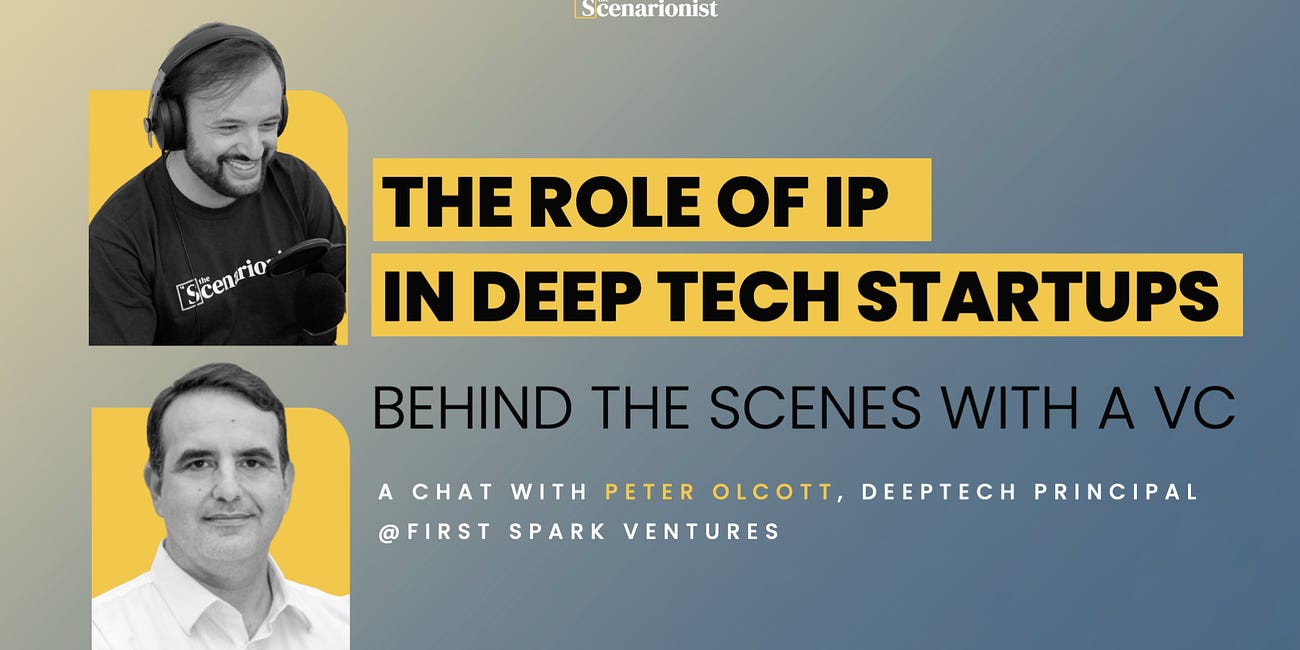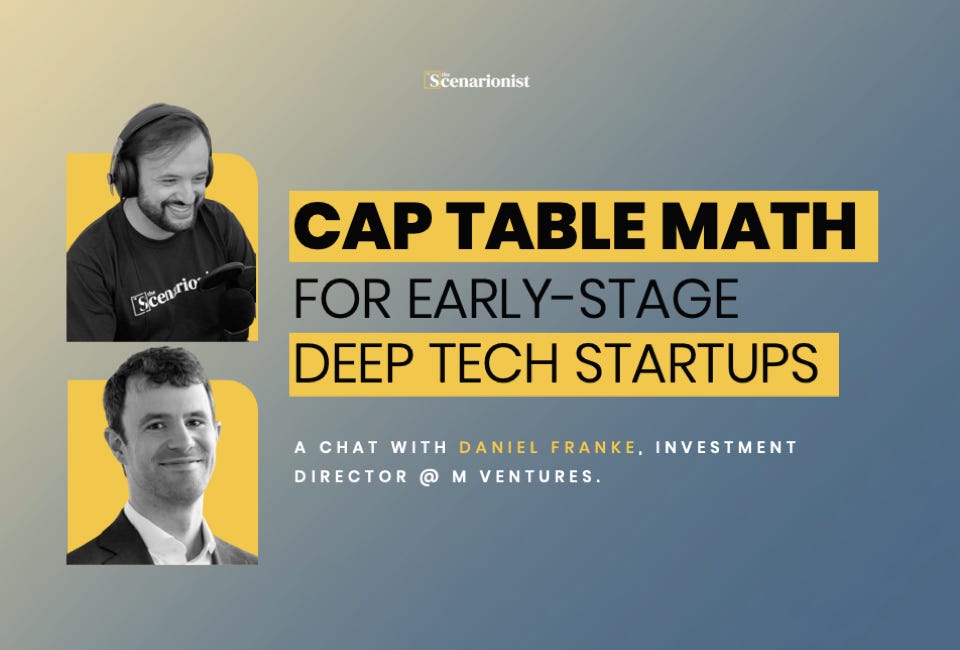Welcome back to Deep Tech Catalyst, the channel by
where science meets venture!
We're thrilled to host Dave Grimm, Partner at AlbionVC!
Today, we'll explore the unique challenges in the pre-seed and seed stages of Deep Tech startups, from the very basics of problem-solution fit to how to approach the first potential B2B corporate partner.
If you are a scientist aiming to learn more about entrepreneurship and commercialization, this is the right episode to watch!
Let's dive into it!
🎧 Prefer to listen?
💡 Problem/Solution Fit in Deep Tech Startups
One of the most common challenges faced by founders, especially those with groundbreaking technological innovations, is the quest to find market fit. It's a journey from zero to zero, where every step is crucial in identifying and engaging the first real customer.
When you've developed a new technology or innovation, the first task is to figure out where it fits in the world.
This might seem obvious in some cases, such as creating a hydrogen fuel cell for mobility. However, even within a broad category like mobility, there are various niches to explore—large vehicles, small vehicles, trains, buses, planes, and more.
In Pre-Seed Stage Problems Come First
In pre-seed stages, achieving product-market fit might seem like a distant goal, especially in Deep Tech. Instead, the focus should be on finding problem-solution fit.
This involves getting out there and speaking directly to potential customers to understand if they have a problem that your technology can solve.
One common pitfall for technologists and inventors is their deep attachment to their technology. They love their creation and are eager to showcase its brilliance.
However, this passion can hinder the process of finding problem-solution fit.
Instead of overwhelming potential customers with details about their technology, founders need to shift their focus to understanding the customer's world.
I often advise technologists to approach potential customers with humility and curiosity. Rather than leading with their technology, they should delve into the customer's day-to-day challenges, priorities, and pain points.
At University College London (UCL), I've implemented a structured interview approach for academics in the pre-seed stage. This approach allows them to gather insights about the end-users' needs without revealing the specifics of their technology until later in the conversation.
By understanding the customer's problems deeply, founders can avoid wasting time and resources on solutions that don't align with the market's needs. It's about shifting the mindset from "I have this beautiful technology" to "I want to understand people's problems.”
👨🔬 When to Start Market Research along the R&D Path?
In the journey of technological innovation, especially in the context of spinouts from research institutions, finding the right balance between technology enthusiasm and business viability is crucial.
So, when is the opportune time to engage with potential customers and gather feedback? In other words: when to transition from technology development to product development?
While some might argue that it's never too early to seek feedback, it's essential for researchers to have a clear understanding of the capabilities they're developing.
It's not just about the Technology Readiness Level (TRL) but more about grasping the practical reality of what the technology can offer. Without this understanding, it becomes challenging to ask the right questions and focus on the most pertinent aspects.
IP > Market Research
In the realm of intellectual property (IP), the decision of when to engage with customers becomes intertwined with IP strategy. Filing for IP protection before engaging deeply with customers is often advisable to safeguard valuable innovations. However, there are ways to conduct market research without revealing proprietary information, focusing instead on understanding customer problems and needs.
🤝 How to Manage Early B2B Relations?
When it comes to introducing radical innovations to the B2B market, navigating corporate structures and relationships can be a daunting task. While new technologies hold the promise of radical solutions, B2B customers often approach them with skepticism and require extensive education.
One common pitfall is the allure of engaging with Innovation teams within large corporations. While these teams are tasked with exploring new ideas, their enthusiasm doesn't always translate into tangible business outcomes. Engaging with an innovation team can sometimes lead to stagnation, with little progress made towards adoption by the core business units.
Instead, it's essential to approach potential customers mindfully and strategically.
Rather than focusing solely on innovation teams, seek sponsorship from business unit leaders who have a stake in the technology's success. By involving the end customer early in the process, you ensure that the solution addresses real pain points and aligns with the organization's bottom line objectives.
Again, Start from Your Customer’s Problem
Effective engagement with early adopters requires a deep understanding of their problems and priorities. This goes beyond surface-level conversations and involves speaking directly with those who experience the challenges firsthand. By doing so, you gain insight into the intensity and nuances of their pain points, allowing you to tailor your solution accordingly.
Moreover, it's crucial to approach these engagements with a clear objective in mind. Whether it's securing a meeting with the head of a business unit or gaining commitment for further collaboration, clarity and transparency are key.
By setting clear expectations from the outset, you increase the likelihood of meaningful progress and avoid getting stuck in the Innovation team's sandbox.
In summary, successful engagement with early adopters requires a strategic approach that balances enthusiasm with pragmatism. By involving key stakeholders from the outset and focusing on real-world problems, you pave the way for meaningful partnerships and the successful adoption of your innovative solutions.
📃 Decoding Term Sheets
A term sheet is essentially a preliminary agreement outlining the key terms and conditions of a potential investment deal between a startup and a venture capital (VC) firm. Think of it as a blueprint for the investment transaction.
In simple terms, when a startup pitches to VCs seeking investment, the goal is to secure commitments from investors.
A term sheet is what outlines the basic terms of these commitments, such as:
the amount of investment,
the valuation of the company,
and any specific rights or conditions attached to the investment.
It's important to note that a term sheet is not legally binding, but it serves as a framework for the subsequent legal documents that formalize the investment agreement. There are generally two types of term sheets:
Funded Term Sheet: This is when a VC commits to investing a specific amount of money in the startup's funding round. If the startup accepts the terms outlined in the funded term sheet, it can rely on the VC's commitment to provide the agreed-upon investment amount.
Unfunded Term Sheet: In this scenario, the VC agrees to invest a portion of the funding round, but the remainder of the investment still needs to be secured by the startup. The VC's commitment in the unfunded term sheet is contingent upon the startup successfully raising the remaining funds from other investors.
While term sheets are not legally binding, they are typically considered to be commitments by both parties. However, it's essential for founders to review the terms carefully and seek legal advice before signing any agreements.
📈 Why do Traditional VC Metrics May Not Fit in Early-Stage Deep Tech?
The traditional metrics for assessing startups, such as revenue, customer acquisition, or user metrics, often don't apply neatly to deep tech ventures at their nascent stages.
Unlike B2B SaaS or consumer tech startups, deep tech startups frequently lack these tangible metrics due to the nature of their innovation and longer development cycles.
As such, investors like myself must look beyond the standard playbook and seek alternative signals of potential success.
Problem-Solution Fit: Have the founders conducted thorough research to identify and understand the problem they're solving? Are there clear indications that their solution addresses a genuine market need? I look for evidence that the founders have engaged with potential customers to validate their assumptions and articulate the problem-solution fit convincingly.
Technical Capability and Differentiation: Is the technology truly groundbreaking, offering a significant improvement over existing solutions? I assess the technical capabilities of the product and evaluate its differentiation in the market. It's crucial to ensure that the solution remains differentiated for the long term, considering the competitive landscape and future technological advancements.
Founder Attributes and Flexibility: I pay close attention to the founders' attributes, including their resilience, adaptability, and willingness to learn. Are they open to feedback and coaching? Are they capable of leading the company through the challenges of scaling a Deep Tech startup? Additionally, I look for founders who demonstrate humility and flexibility, recognizing that their roles may evolve over time and being open to bringing in additional expertise as needed.
This is all for today!
Before you go 👉 Subscribe to make sure you catch all new episodes and our weekly briefing, where we dive into the latest trends and updates shaping the world of Deep Tech!























